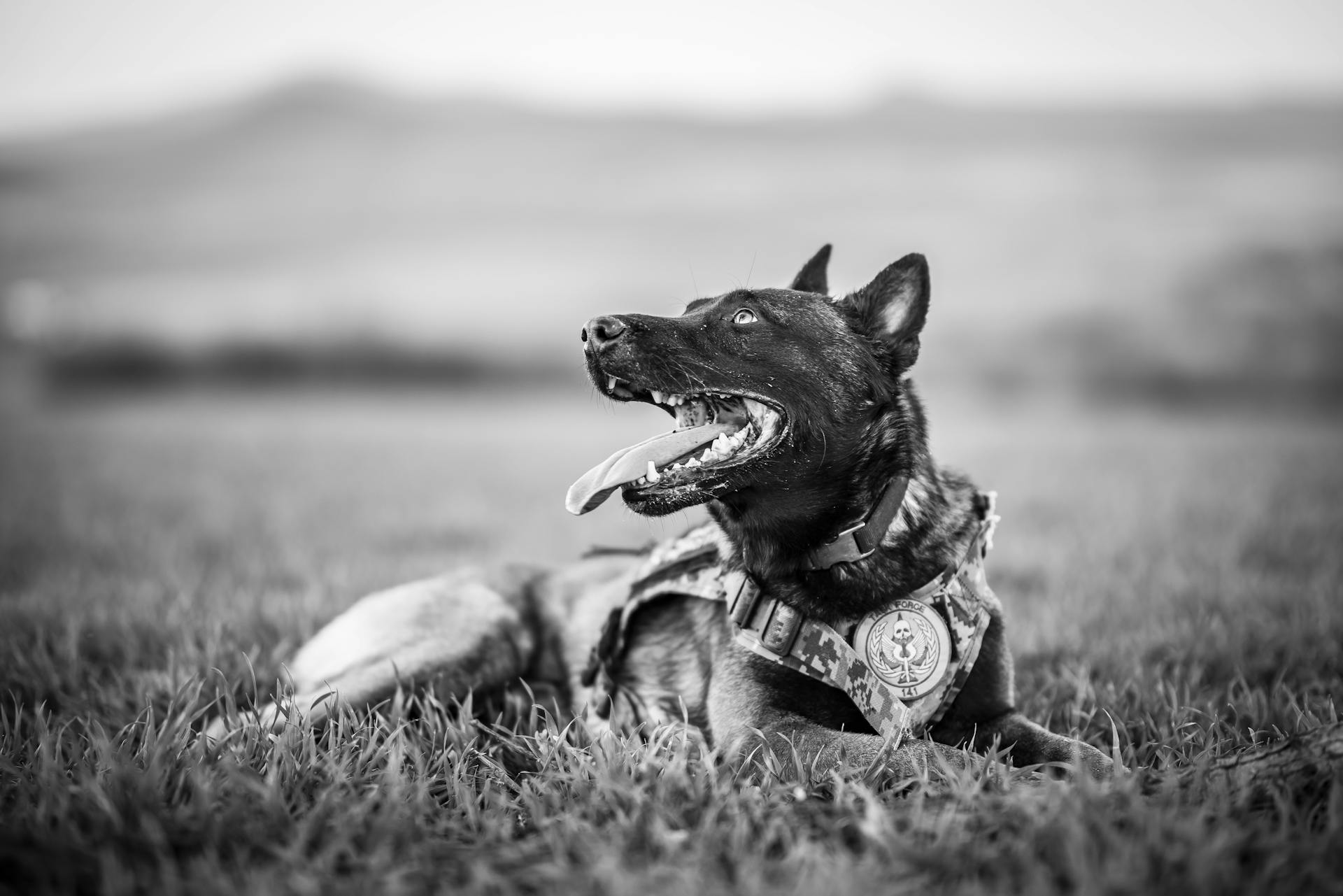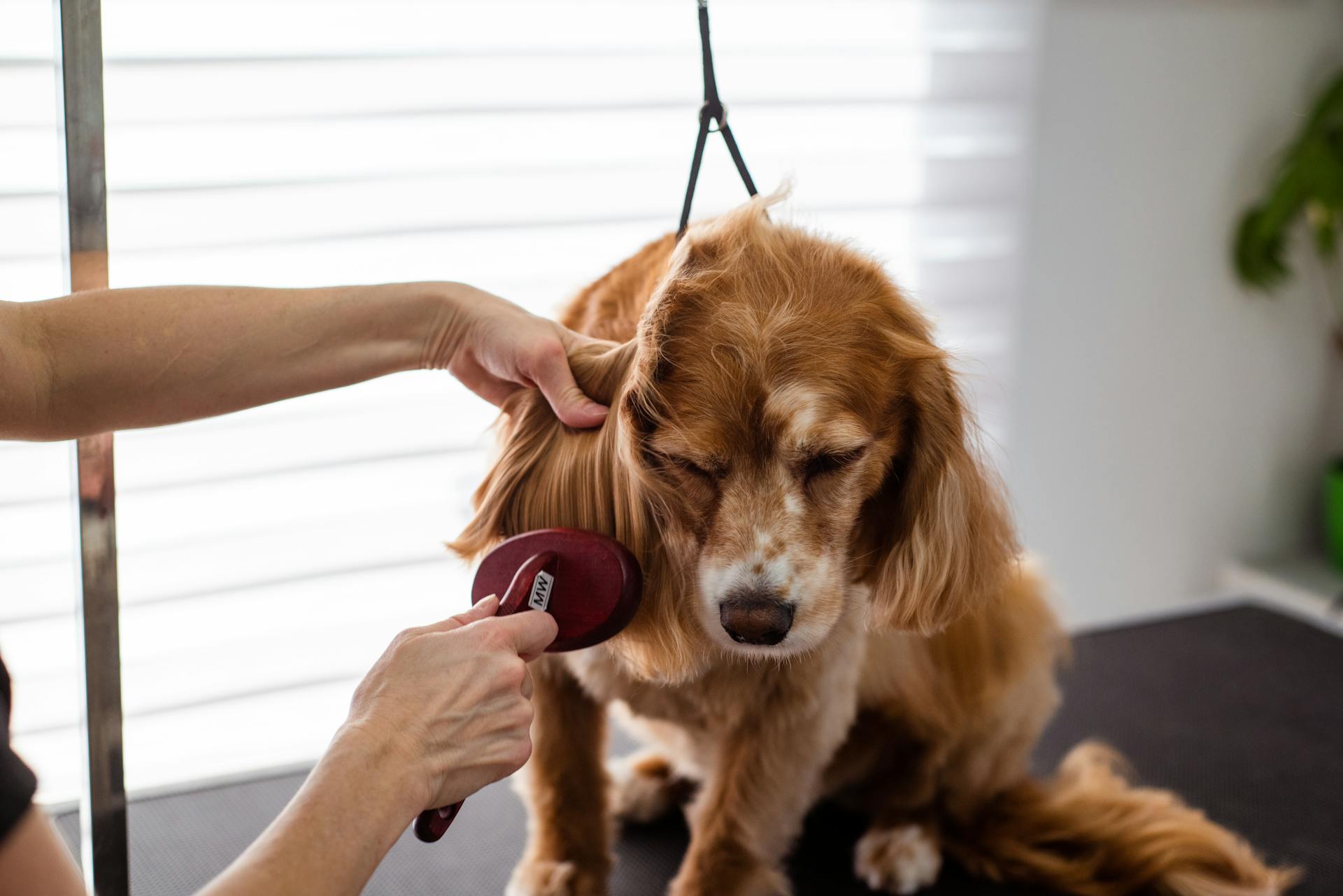
Dogs need access to plenty of fresh water throughout the day to stay healthy and happy.
The general rule of thumb is that a dog should drink at least one ounce of water per pound of body weight daily.
Dogs that are more active or live in hot climates may need even more water to compensate for their increased fluid loss.
A 10-pound dog, for example, should aim to drink at least 10 ounces of water daily.
Additional reading: How Much Exercise Does My Dog Need Calculator?
Understanding Dog Hydration Needs
Dogs can regulate their water intake as long as they have access to fresh water sources. However, there are ways to estimate how much water your dog should be drinking.
For dry food diets, a common estimate is 1 mL of water for every calorie consumed. You can also use the formula: mL water required = 2-3 times dry matter intake (in grams). Another estimate is around 23 mL per pound body weight.
A standard human drinking glass holds 16 ounces of water, which is roughly equivalent to 473 mL. This means that smaller dogs may not even require a full glass, while larger dogs should drink the equivalent of more than 3 full glasses.
Dogs eating a wet food diet, like canned foods, have much lower water needs because the moisture content of the diet is significantly higher.
Factors Affecting Water Intake
A dog's water intake can vary greatly depending on several factors.
Highly active dogs need more water than their less active counterparts. Exercise and heat can increase water loss, so it's essential to provide extra water on hot days or after a long walk.
Age also plays a significant role in determining water needs. Puppies tend to be more active and may require more water than mature dogs. Conversely, mature dogs may have medical conditions or medications that increase their water needs.
Diet can also affect water intake. Dogs eating canned food or a homemade diet may receive some moisture through their food, reducing the need for additional water. However, dogs eating dry kibble may need to drink more water to stay hydrated.
On hot summer days or after intense exercise, dogs need access to even more fresh, clean water to regulate their body temperature, digest their food, and stay hydrated.
Here are some general guidelines for water intake based on a dog's diet and activity level:
Remember, every dog is different, and their water needs may vary depending on their individual circumstances. If you're unsure about your dog's water intake, consult with your veterinarian for personalized advice.
Signs of Dehydration
Dehydration in dogs can be a serious issue, so it's essential to recognize the signs early on. A dry nose is a common indicator of dehydration, and excessive panting can also be a warning sign.
If your dog's skin doesn't spring back quickly when you gently pinch it between the shoulder blades, it may be a sign of dehydration. You can also check for dry, sunken eyeballs and pale, sticky gums.
Here are some key signs to keep in mind:
- Excessive panting
- Lethargy or increased tiredness
- Dry nose and mouth
- Decreased skin elasticity
If you suspect your dog is dehydrated, it's crucial to take them to the veterinarian for rehydration as soon as possible.
Why You Might Be Overestimating
Overestimating your hydration levels can be a common mistake, especially if you're not paying attention to your body's subtle signs.
You might be overestimating your hydration levels if you're not drinking enough water throughout the day.
Many people don't realize they're dehydrated until they experience severe symptoms, but mild dehydration can be sneaky, making you feel tired and sluggish.
If you're not urinating frequently enough, it could be a sign that you're not drinking enough water.
In fact, if you're only urinating 4-7 times in a 24-hour period, it's likely a sign of dehydration.
It's also easy to mistake thirst for hunger, leading to overeating or making poor food choices.
Broaden your view: Dogs Drinking
Dehydration Signs
Dehydration can sneak up on us and our furry friends, so it's essential to know the signs. A dry nose and mouth are two common indicators of dehydration in dogs.
Gums that appear dry, sticky, or pale are another sign to watch out for. You can also check skin elasticity by gently pinching the skin between your dog's shoulder blades and releasing it. If the skin returns quickly, your dog is likely hydrated. If it takes time to fall back into place, dehydration might be present.
Excessive panting and lethargy or increased tiredness can also be signs of dehydration. Dry eyeballs and decreased skin elasticity are other warning signs to look out for.
Here are some key signs to keep in mind:
- Dry nose and mouth
- Dry, sticky, or pale gums
- Excessive panting
- Lethargy or increased tiredness
- Dry eyeballs
- Decreased skin elasticity
Preventing Dehydration
Dogs need access to fresh, clean water throughout the day.
A dry nose, panting, fatigue, dry gums, and thick saliva are all warning signs that your dog is dehydrated.
To prevent dehydration, give your dog a simple test: gently grab some skin on their back using your thumb and forefinger, then release it. If the skin returns to its original position quickly, they're likely hydrated.
Fresh, clean water is key to keeping your dog hydrated. Free drinking is a must, so make sure water is always available.
Dogs may prefer water that's cool or moving, so try pouring it in front of them or using a fountain-like dispenser.
Regularly check that the bowl is clean and you're changing the water frequently enough to ensure your dog stays hydrated.
Curious to learn more? Check out: Extra Skin
Managing Excessive Water Intake
If your dog is drinking an excessive amount of water, it's essential to monitor their intake and consult with your veterinarian. Your veterinarian can help determine the cause of excessive drinking, which may be due to various factors such as hot weather, high activity level, or underlying medical conditions.
Pregnant or lactating female dogs, for example, need more water to meet their nutritional demands. Similarly, highly active dogs will require more water than those who prefer to lounge around. Canned food, which has a high moisture count, can also affect water intake in dogs.
If you're concerned about your dog's water intake, talk to your veterinarian for advice. They may ask you to measure your dog's water intake and separate them from other pets. Your veterinarian can then develop a treatment plan to get your dog's drinking habits back to normal.
You might enjoy: Female Dog Drinking a Lot of Water
What If You Are Excessive?

If you notice your dog drinking or urinating more than usual, it's essential to let your veterinarian know. There are many potential causes for this problem.
A thorough physical examination along with blood or urine tests can help your veterinarian determine the next steps. You might be asked to measure your pet's water intake, which may require separating them from other pets.
You should still provide an excess amount of water, but measuring how much you add to the bowl and how much is left at the end of each day is crucial. This will help you estimate the total amount of water your dog drinks in a day.
If you're concerned that your dog is not getting enough water to maintain their health, or is drinking too much water, talk to your veterinarian for advice. Maintaining proper hydration is too important to ignore.
If this caught your attention, see: Is Chlorine Water Bad for Dogs
What to Do If You're Overweight
If you're overweight, it's essential to address the issue to prevent related health problems. Overweight individuals are more likely to experience health conditions that can lead to excessive water intake, such as kidney disease.

Your veterinarian will perform some tests to determine why your dog is drinking so much water, then develop a treatment plan to get your dog's drinking habits back to normal. This is a great reminder that a similar approach can be applied to managing excessive water intake in humans.
Overhydration is a serious medical concern that can cause vomiting, lethargy, and bloating. This is a warning sign that you should take seriously, especially if you're experiencing these symptoms.
You'll know if your dog drinks more water than usual if you have to fill up your dog's water bowl more often. Similarly, if you notice yourself reaching for water more frequently, it may be a sign that you're not drinking enough water or that there's an underlying issue.
The medical term for excessive water drinking is polydipsia. This term is also used to describe excessive water intake in dogs, highlighting the importance of monitoring our own water consumption.
Drinking too much water can also upset your dog's electrolyte balance. This is a crucial consideration for humans as well, especially if you're engaging in high-intensity activities or experiencing excessive sweating.
Tips and Considerations
Monitoring your dog's water intake is crucial to ensure they're drinking enough. Closely monitor your dog's water intake by refilling their bowl at approximately the same time each day and note how much water is left in the bowl.
Preventing your dog from drinking from the toilet bowl is a must. The toilet bowl may look clean, but there can be lots of disease-causing bacteria lurking in the bowl, so keep the toilet lid closed and close the bathroom door.
Cleaning your dog's water bowl regularly is essential. Clean your dog's water bowl with soap and water daily to prevent a buildup of debris and bacteria that could make your dog sick.
Here are some key tips to keep in mind:
- Closely monitor your dog's water intake.
- Prevent drinking from the toilet bowl.
- Clean your dog's water bowl daily.
If your dog's drinking habits seem off, it's time to schedule a vet appointment. Your veterinarian can help figure out why your dog's water intake is abnormal and provide guidance on how to restore their normal water intake.
Frequently Asked Questions
Should you leave water out for a dog all day?
Yes, you can leave water out for your dog all day, but consider rationing it to prevent overconsumption. To do this, fill the bowl only half or a quarter of the way each time to ensure steady access to water.
Is it OK to limit a dog's water intake?
No, it's not recommended to limit a dog's water intake, as it can worsen certain conditions. Always ensure your dog has access to plenty of fresh water
Sources
- https://www.petmd.com/dog/nutrition/evr_dg_the_importance_of_water
- https://www.dailypaws.com/dogs-puppies/health-care/how-much-water-should-a-dog-drink
- https://www.nomnomnow.com/learn/article/dog-water-calculator
- https://www.thefarmersdog.com/digest/how-to-keep-your-dog-hydrated/
- https://emancipet.org/blog/2021/07/how-much-water-should-my-dog-or-cat-drink/
Featured Images: pexels.com


